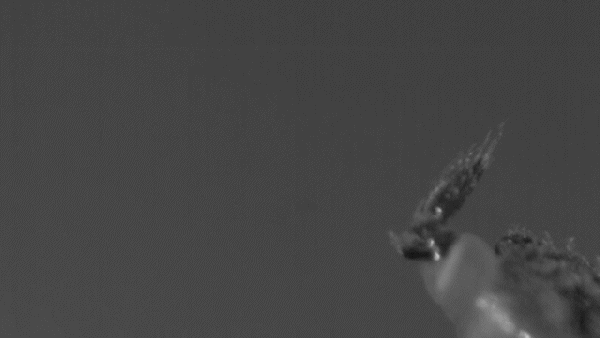These Tiny Bugs Urinate by Flinging Droplets of Pee
Sharpshooters are the first example of “superpropulsion” in a living organism, according to new research

How do bugs urinate? It’s a question most people will never consider—but Saad Bhamla is not most people.
Bhamla, a biophysicist at the Georgia Institute of Technology, was in his yard one day when he spotted a tiny bug relieving itself and “fell in love,” as he tells Live Science’s Charles Q. Choi. The insect, called a glassy-winged sharpshooter, appeared to be using its tail to fling away small droplets of pee, one at a time.
Curious about this unique mechanism, Bhamla decided to investigate. He wondered if the insects—which are smaller than the tip of a human pinky finger—had evolved some sophisticated engineering or physics process for undertaking this necessary bodily function.
And for sharpshooters, peeing is definitely a necessity. The bugs spend a lot of their time urinating, because their diet consists primarily of plant xylem sap, a substance that contains small amounts of minerals and nutrients. They can drink up to 300 times their body weight in xylem sap each day, and because it’s 99 percent water, this means they’re also constantly excreting the excess liquid.
Other insects also feast on xylem sap, but they urinate by creating jet streams. The sharpshooters’ method, however, is much more energy-efficient, according to a new paper that Bhamla and others published in Nature Communications on Tuesday. They report that sharpshooters twist a part of their anus to propel urine droplets at high speeds, a process that expends four to eight times less energy than producing a stream.
“If you were only drinking diet lemonade, and that was your entire diet, then you really wouldn’t want to waste energy in any part of your biological process,” Bhamla tells New Scientist’s Christa Lesté-Lasserre. “That’s sort of how it is for this tiny organism.”
To investigate the sharpshooter’s pee-flinging prowess, researchers used high-speed videos and microscopy to observe five glassy-winged sharpshooters. In total, they watched the creatures urinate 22 times.
Their observations revealed that sharpshooters have a special appendage called an anal stylus, which the researchers nicknamed the “butt flicker.” When the sharpshooter needed to urinate, it opened and rotated its anal stylus to produce a droplet. Once the droplet reached an optimal size, the anal stylus rotated backward even more, then launched the urine away from the bug’s body at a high speed.
Intriguingly, the urine droplets moved 40 percent faster than the anal stylus did when it catapulted them into the air. This surprised the researchers, who had expected them to move at the same speed. They realized they had discovered evidence for superpropulsion, a rare mechanical principle that had never been observed in a living organism before.
Superpropulsion—in which a projectile moves faster than its launching device—all comes down to timing. Like a diver bouncing on a springy diving board before launching up over the water, the droplets were compressed by the anal stylus, storing energy until the moment of launch.
Scientists have experimented with superpropulsion in laboratories, but sharpshooters “came up with the idea hundreds of thousands, if not millions, of years before us,” Bhamla tells Scientific American’s Jack Tamisiea.
Other animals use appendages such as latches or springs to propel themselves through the air, but none are quite like sharpshooters. “Nature has evolved these mechanisms to circumvent some of the limitations of muscles or volume constraints, because some of these insects are so small,” Aimy Wissa, a mechanical engineer at Princeton University who was not involved in the study, tells Scientific American.
/https://tf-cmsv2-smithsonianmag-media.s3.amazonaws.com/filer_public/e1/ea/e1ea5578-86f5-4a50-b7cf-0baf921f3f84/img_1232.jpeg)
The sharpshooters’ movements are all the more impressive when considered at a larger scale. Their pee-flinging process is the equivalent of humans “trying to fling away a beach ball-sized globe of maple syrup that was stuck to our hand,” says Miriam Ashley-Ross, a biology program director at the National Science Foundation, which partially funded the work, in a statement.
The findings might someday solve human-sized problems, too. They may help engineers figure out how to remove water from electronics such as smart watches or develop systems that can defog eyeglasses and goggles by vibrating their surfaces.
“The subject of this study may seem whimsical and esoteric, but it’s from investigations like this that we gain insight into physical processes at size scales outside of our normal human experience,” Ashley-Ross says in the statement.
/https://tf-cmsv2-smithsonianmag-media.s3.amazonaws.com/accounts/headshot/SarahKuta.png)


/https://tf-cmsv2-smithsonianmag-media.s3.amazonaws.com/accounts/headshot/SarahKuta.png)